Anyone Else Love Squids As Much As We Do? (Qeue Slow-motion Tentacle-raise) 🙋🏻
Anyone else love squids as much as we do? (Qeue slow-motion tentacle-raise) 🙋🏻
Galiteuthis phyllura, also known as the cockatoo squid, lives in the North Pacific from 200 to over 1,000 meters (660 to 3,280 feet) deep. This species has a transparent body and photophores, or light organs, under their eyes. We often encounter them hanging horizontally in the water column with their arms raised above their heads.
More Posts from Simplyphytoplankton and Others
Daily Life
Weekdays
Weekends
Buses
Food
Daily life here in Costa Rica, at least for me, is not necessarily all that different or much more exciting than daily life in the U.S. The major difference is since my workload is a lot lighter here, I have a lot more free time.
A typical week may play out like this. Every day, I usually get up between 7:30-8:00 am. Even on weekends when I don’t have plans, my body is used to waking up early and I usually never sleep to my alarm. This may be because the sun is always up my 6:00 am and my internal body clock has just adjusted to this. On Monday, I don't have class until 1 pm, but I usually don't get home until 7:30-8:00 pm, which makes Monday my busiest day. I usually spend the first half of the day doing random stuff, unless I have something I need to prepare for a class, such as an exam or presentation. On Tuesday, I have class at 10:00 am until 11:40 am, and I have a break to go back home and eat lunch before I have my other class at 3:00 pm, which usually is a little under two hours.
By Tuesday night, I usually pretty tired (since Monday is always a long day) and I don't do too much since I have no class on Wednesday. This makes Wednesday a day to relax or get a head start on work for Thursday and Friday. Occasionally, I have gone on day trips. For example, one week I went somewhere with my host mom for the day and last week, I went to San José to visit two museums. The rest of my week is really easy class wise, with only one class Thursday and Friday, with both starting at 10:00 am.
On weekends, I've gone on quite a few trips, some sponsored by IFSA and some as a part of a class. Otherwise, I may go a few places with my host parents, do watch, or watch a few things on Netflix.
In order to get around, I usually take the bus. I live in Barva and la Universidad Nacional is in Heredia, so I always need to take the bus to get to and from class. One round trip costs about $0.35, and it can take anywhere from 10-30 minutes for the bus to get from Barva to Heredia or vice versa, but it usually takes about 15-20 minutes. Other buses, to San José for example, cost a bit more, but still under $1 one way usually unless it's a few hour trip. That being said, if you plan out which buses you need to take, it is pretty easy to get around, even if you're used to having a car like me.
With my host family, breakfast usually consists of eggs a mix of rice and beans called gallo pinto. We usually have freshly-squeezed orange juice as well, and my host parents also drink coffee. We sometimes have cereal or an egg sandwich too. Lunch and dinner are usually pretty similar, and almost always include rice and beans (a staple in Costa Rica). Sometimes my host mom needs to make food that's a little bit different for me because I'm a vegetarian. We almost always have either some type of fruit juice, usually made of cas, but sometimes mango, pineapple, or watermelon, or iced tea. I usually like everything my host mom makes. I don't have to do any of my own laundry, which is very different from college in the U.S. If my host mom does not do it, the maid that comes on Mondays and Fridays comes.





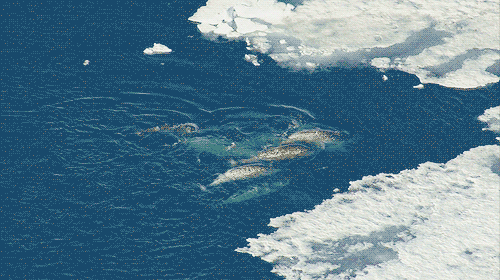



Trump’s War on Science continues

Meet MBARI: This team develops innovative new technology to map the seafloor 🤖🗺️
With marine life and ecosystems facing a rising tide of threats, the ocean exploration community needs nimble, cost-effective tools for measuring and monitoring ocean health. MBARI’s Control, Modeling, and Perception of Autonomous Systems Laboratory, known as the CoMPAS Lab is up to the challenge.
MBARI scientists and engineers build and adapt advanced technology that enhances ocean data collection. Led by engineer Giancarlo Troni, the CoMPAS Lab team develops scalable marine technology that can easily be modified for use in a wide variety of vehicles and platforms.

Working with other teams across MBARI, the CoMPAS Lab leverages vehicles like the MiniROV to deploy and test new tools in Monterey Bay's submarine canyon and then adapt them for other mobile platforms. By sharing open-source design specifications and advanced algorithms with the wider ocean exploration community, we hope to expand access to MBARI’s engineering innovations.
MBARI technology is transforming what we know about the ocean and its inhabitants. Our scientists, engineers, and marine operations staff work together to create innovative tools for a more sustainable future where autonomous robots and artificial intelligence can track ocean health in real time and help us visualize ocean animals and environments. Studying our blue backyard is revealing our connection to the ocean—how it sustains us and how our actions on land may be threatening its future.

We’re spotlighting various teams at MBARI to showcase the different ways we’re studying the largest environment on Earth. We hope this series inspires a new generation of ocean explorers. Dive in.
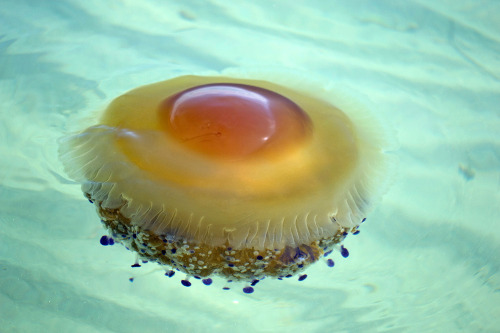

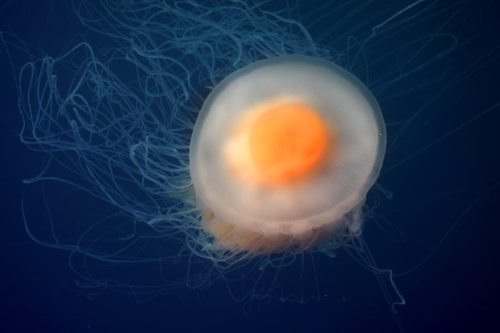
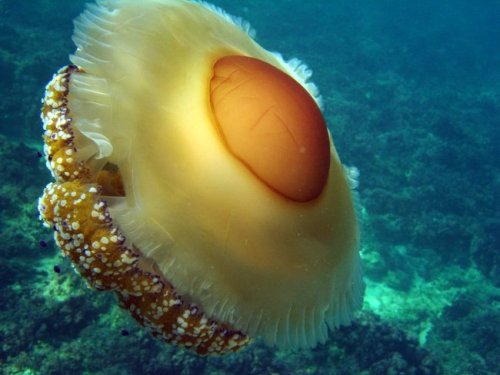
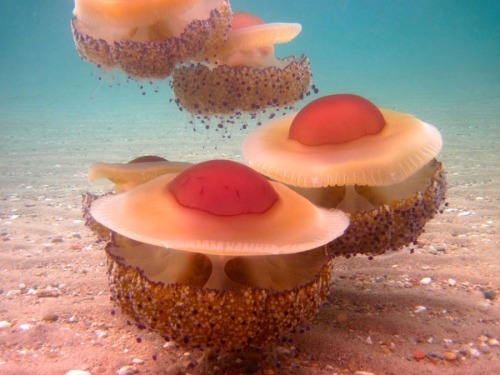
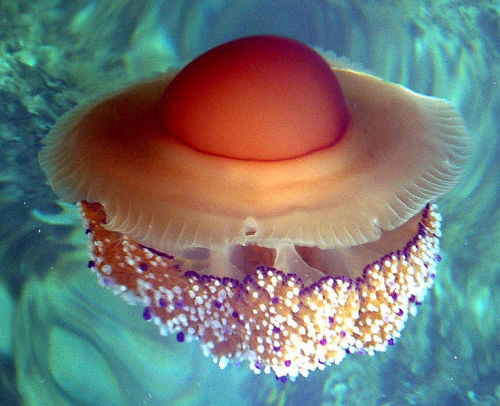
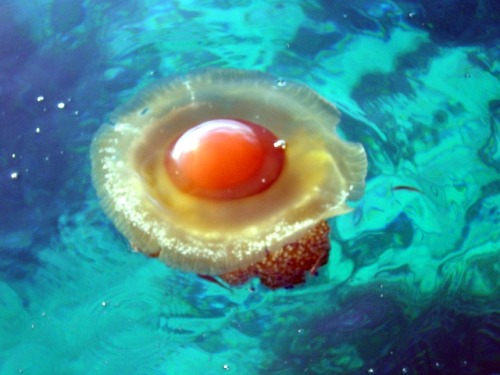
Fried Egg Jellyfish Are Kind of Adorable – & That’s No Yolk.
There are two species that hold the whimsical title of “Fried Egg Jellyfish”: Phacellophora camtschatica and Cotylorhiza tuberculata though the two are quite different from each other in all aspects beside appearance.
Phacellophora camtschatica is a huge jelly that prefers colder waters. It’s bell can reach up to 2 ft across and its dozens of tentacles reach over 20 ft long! If you don’t think this floating egg creature looks very menacing, you’d be right. It has a very weak sting and many small crustaceans take advantage of the jelly by riding on its bell (breakfast to go…?) while snatching up extra food.
Cotylorhiza tuberculata is a much smaller jellyfish that hangs out in warmer waters. It only reaches about 35 cm in diameter, so don’t go for this Fried Egg Jelly if you want a big breakfast. Unlike most jellyfish, C. tuberculata can swim on its own, without relying on the currents for movement. It’s sting (if you can even call it that) is so feeble that it has very little to no effect on humans at all. I mean, it does look like a breakfast food, after all… how powerful could it be?




Dinoflagellates! These bizarre microorganisms are found all over the ocean, and occasionally freshwater lakes and ponds. Some are photosynthetic, some are predators, some are both! They are also the plankton responsible for toxic red tides.
The first two pictures show Pyrocystis dinoflagellates. These are closely related to the dinoflagellates that bioluminesce a bright blue along coastal waters. In the top picture, you can see a cell dividing its nucleus into two, as well as some sort of protective cyst in the lower right corner.
The 3rd picture is a bloom of Gymnodinium dinoflagellates, and the last picture is a close-up. See the nucleus?
More neat facts: some dinoflagellates have 215 billion base pairs in their genome. For comparison, the human genome is made up of about 3 billion base pairs! No one really knows why they have so much DNA, most of which is heavily modified and wrapped with re-purposed virus proteins.

My host dad’s mom’s 86th birthday cake.
-
 elswere-1 liked this · 3 weeks ago
elswere-1 liked this · 3 weeks ago -
 mieme13-blog liked this · 1 month ago
mieme13-blog liked this · 1 month ago -
 krystleanderson liked this · 1 month ago
krystleanderson liked this · 1 month ago -
 eggmixercortex reblogged this · 1 month ago
eggmixercortex reblogged this · 1 month ago -
 murdercide626 reblogged this · 1 month ago
murdercide626 reblogged this · 1 month ago -
 murdercide626 liked this · 1 month ago
murdercide626 liked this · 1 month ago -
 dragomer liked this · 1 month ago
dragomer liked this · 1 month ago -
 cobramonsterboy777 reblogged this · 1 month ago
cobramonsterboy777 reblogged this · 1 month ago -
 zaratustrasworld liked this · 2 months ago
zaratustrasworld liked this · 2 months ago -
 oceanographer-live liked this · 2 months ago
oceanographer-live liked this · 2 months ago -
 wildernestt liked this · 2 months ago
wildernestt liked this · 2 months ago -
 delgado1911 liked this · 2 months ago
delgado1911 liked this · 2 months ago -
 creaturedeityendless liked this · 3 months ago
creaturedeityendless liked this · 3 months ago -
 homeplanets reblogged this · 3 months ago
homeplanets reblogged this · 3 months ago -
 marinelifepoaching liked this · 3 months ago
marinelifepoaching liked this · 3 months ago -
 acanadistic liked this · 3 months ago
acanadistic liked this · 3 months ago -
 dummyontumbl liked this · 3 months ago
dummyontumbl liked this · 3 months ago -
 spinokitty liked this · 3 months ago
spinokitty liked this · 3 months ago -
 shlompy liked this · 3 months ago
shlompy liked this · 3 months ago -
 mbari-blog reblogged this · 3 months ago
mbari-blog reblogged this · 3 months ago -
 mbari-blog liked this · 3 months ago
mbari-blog liked this · 3 months ago -
 sibrownphoto-tumbl liked this · 3 months ago
sibrownphoto-tumbl liked this · 3 months ago -
 394822274949 liked this · 3 months ago
394822274949 liked this · 3 months ago -
 strokkurr liked this · 3 months ago
strokkurr liked this · 3 months ago -
 glitches25 liked this · 3 months ago
glitches25 liked this · 3 months ago -
 demeter1111 liked this · 3 months ago
demeter1111 liked this · 3 months ago -
 sirfowlman liked this · 3 months ago
sirfowlman liked this · 3 months ago -
 jareth32ness liked this · 3 months ago
jareth32ness liked this · 3 months ago -
 epi-rants reblogged this · 3 months ago
epi-rants reblogged this · 3 months ago -
 epi-rants liked this · 3 months ago
epi-rants liked this · 3 months ago -
 littleconch reblogged this · 3 months ago
littleconch reblogged this · 3 months ago -
 tumblebub reblogged this · 3 months ago
tumblebub reblogged this · 3 months ago -
 wildkrattslegendsofzoera liked this · 3 months ago
wildkrattslegendsofzoera liked this · 3 months ago -
 quartofroy liked this · 3 months ago
quartofroy liked this · 3 months ago -
 agateggrate liked this · 3 months ago
agateggrate liked this · 3 months ago -
 nezyu liked this · 3 months ago
nezyu liked this · 3 months ago -
 yourlocalbackalleydoctor reblogged this · 3 months ago
yourlocalbackalleydoctor reblogged this · 3 months ago -
 yourlocalbackalleydoctor liked this · 3 months ago
yourlocalbackalleydoctor liked this · 3 months ago -
 vtatters liked this · 3 months ago
vtatters liked this · 3 months ago -
 coralreaper707 liked this · 3 months ago
coralreaper707 liked this · 3 months ago -
 bugeyedcreature reblogged this · 3 months ago
bugeyedcreature reblogged this · 3 months ago -
 bugeyedcreature liked this · 3 months ago
bugeyedcreature liked this · 3 months ago -
 martinipols reblogged this · 3 months ago
martinipols reblogged this · 3 months ago -
 nemoe222 liked this · 3 months ago
nemoe222 liked this · 3 months ago -
 saltwater-spotter reblogged this · 3 months ago
saltwater-spotter reblogged this · 3 months ago -
 capn-rattlebones liked this · 3 months ago
capn-rattlebones liked this · 3 months ago -
 boss-of-armadildos reblogged this · 3 months ago
boss-of-armadildos reblogged this · 3 months ago -
 alenchikova reblogged this · 3 months ago
alenchikova reblogged this · 3 months ago -
 davidclev liked this · 3 months ago
davidclev liked this · 3 months ago

Blog dedicted to phytoplankton. Phytoplankton are microscopic organisms that are responsible for half of the photosynthesis that occurs on Earth. Oh, and they look like art... Follow to learn more about these amazing litter critters! Caution: Will share other ocean science posts!Run by an oceanographer and phytoplankton expert. Currently a postdoctoral researcher.Profile image: False Colored SEM image of Emiliania huxleyi, a coccolithophore, and the subject of my doctoral work. Credit: Steve Gschmeissner/ Science Photo Library/ Getty ImagesHeader image: Satellite image of a phytoplankton bloom off the Alaskan Coast, in the Chukchi SeaCredit: NASA image by Norman Kuring/NASA's Ocean Color Web https://earthobservatory.nasa.gov/images/92412/churning-in-the-chukchi-sea
158 posts
